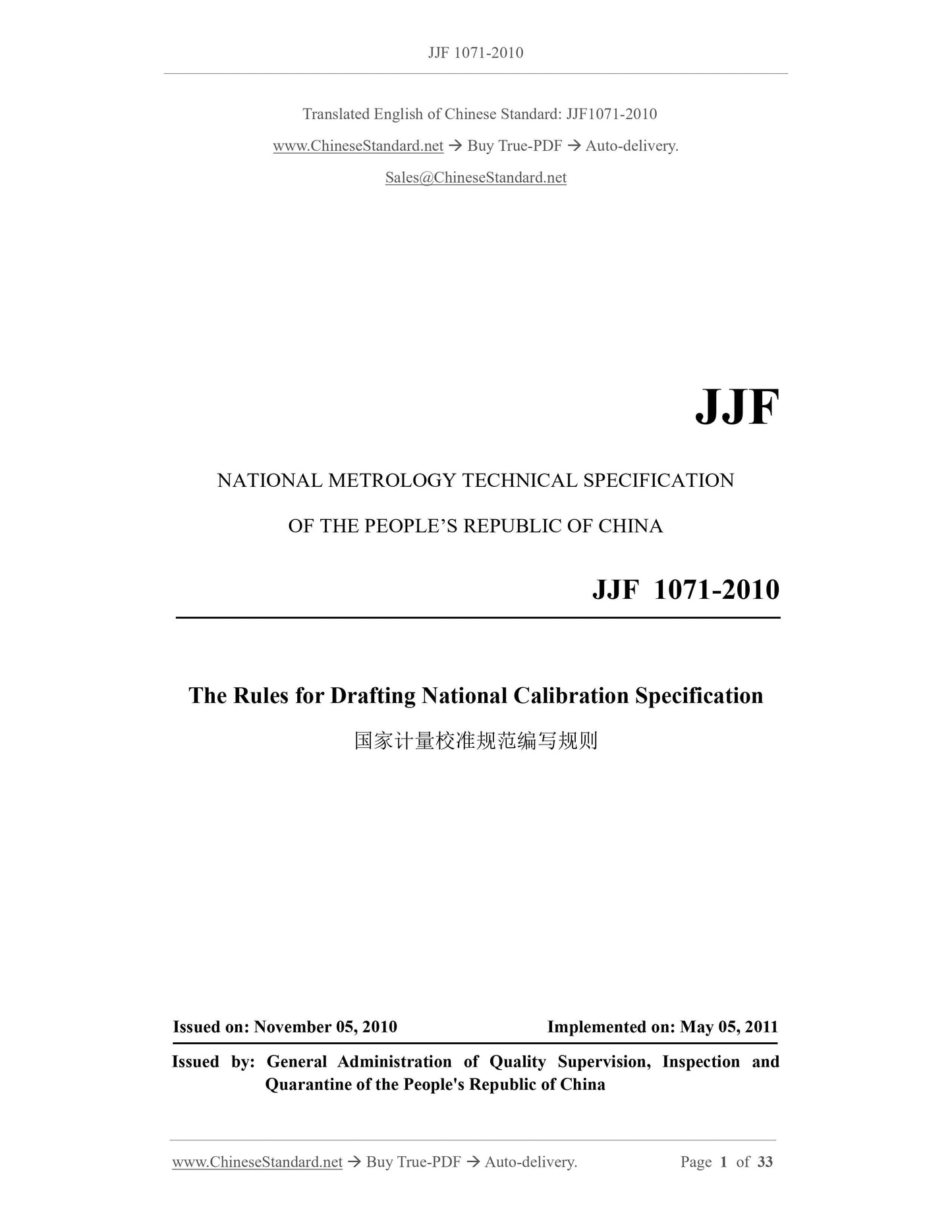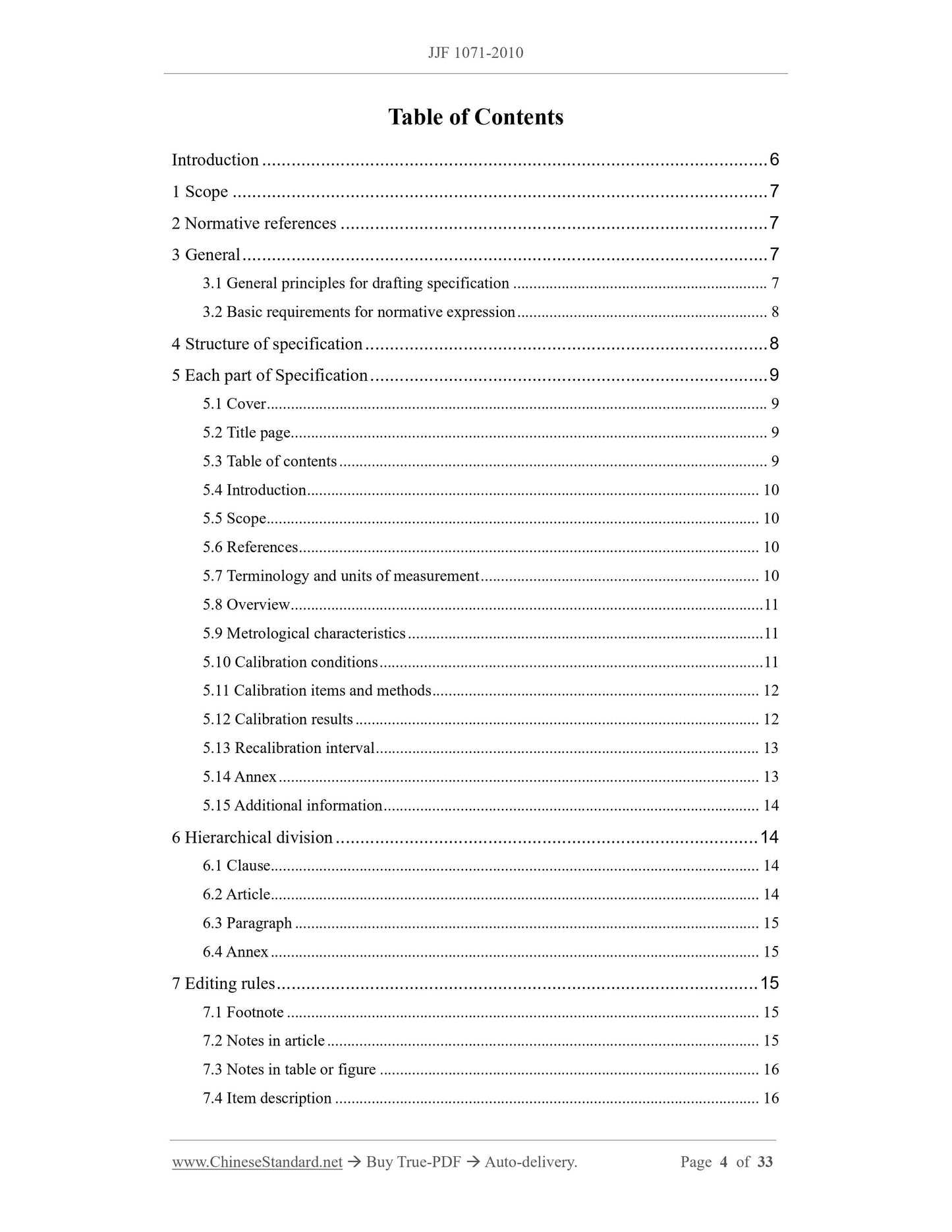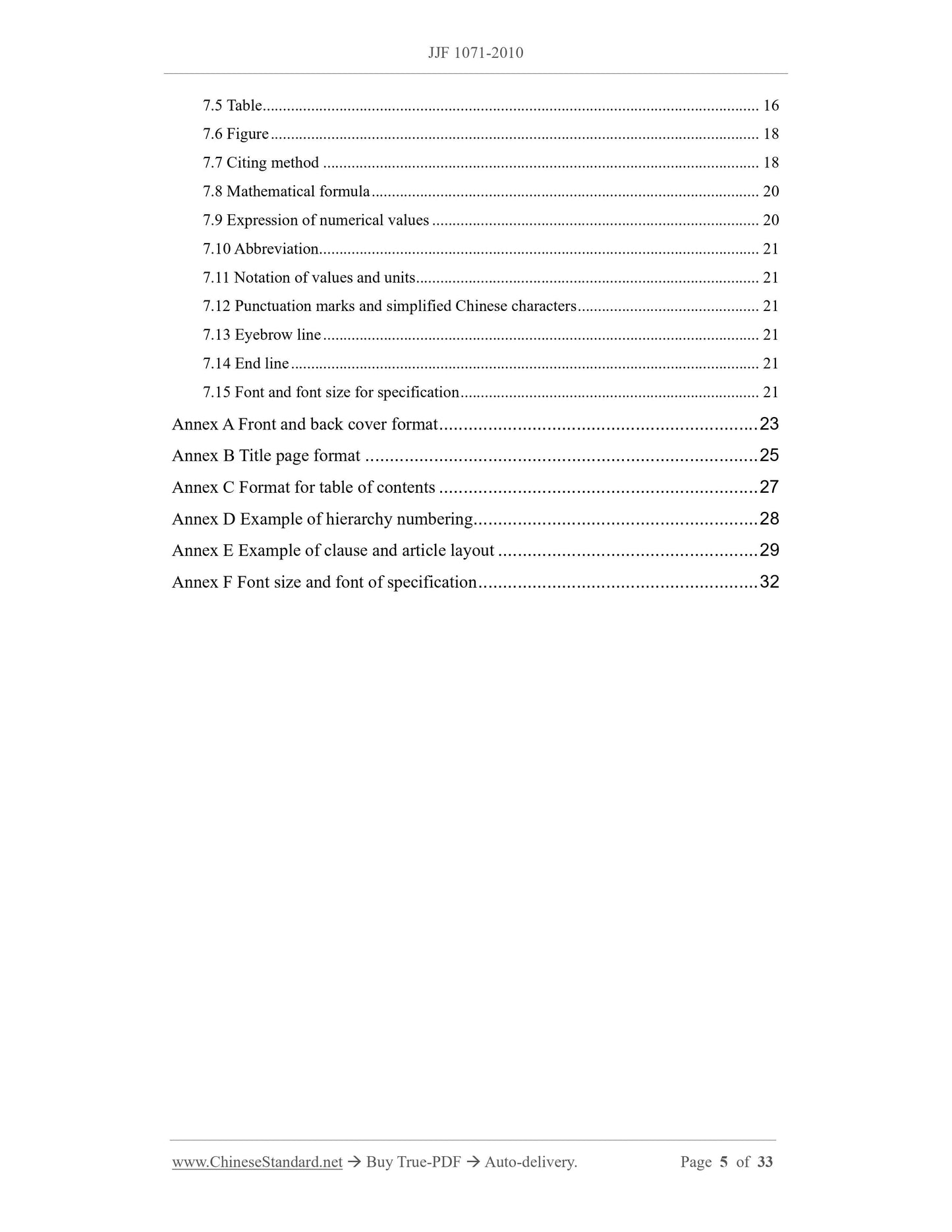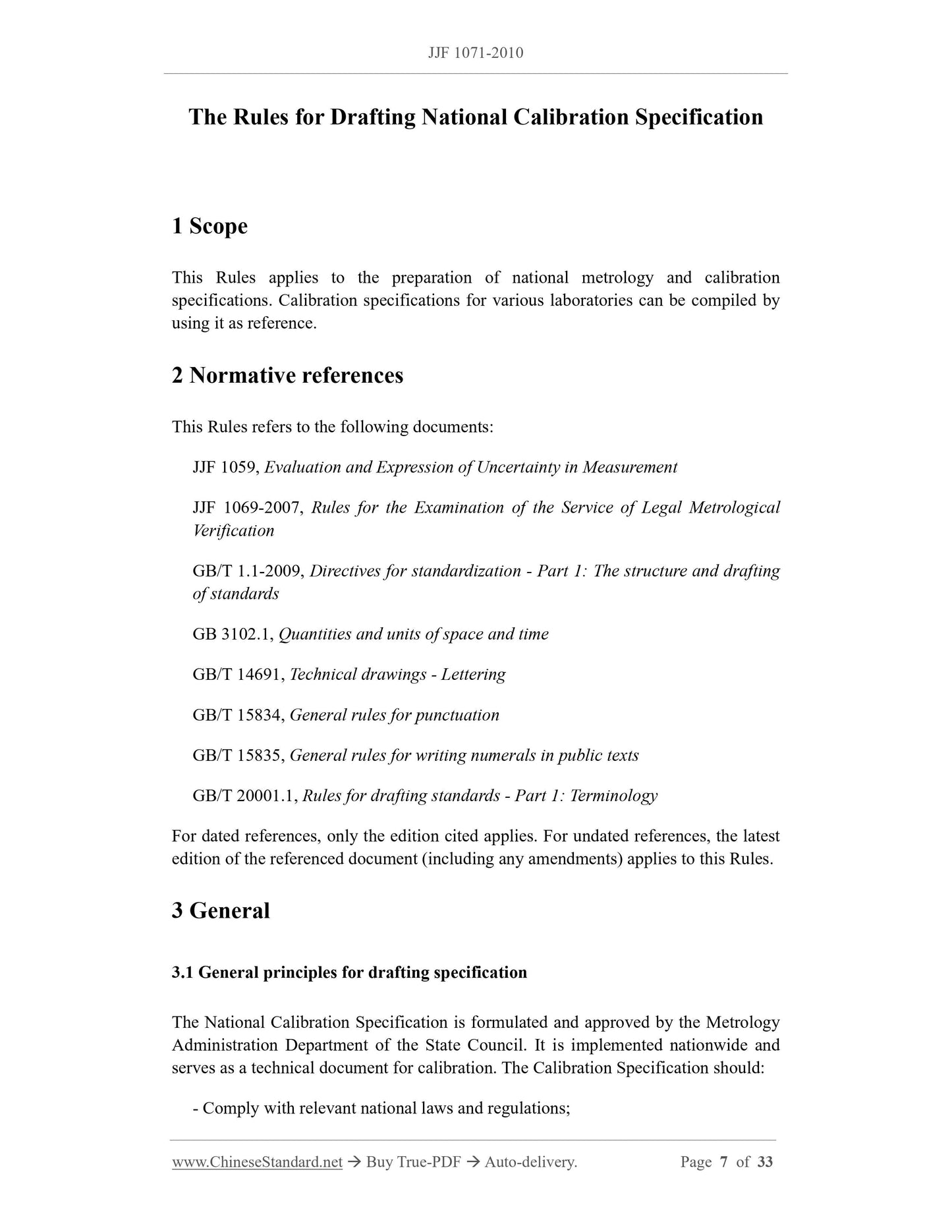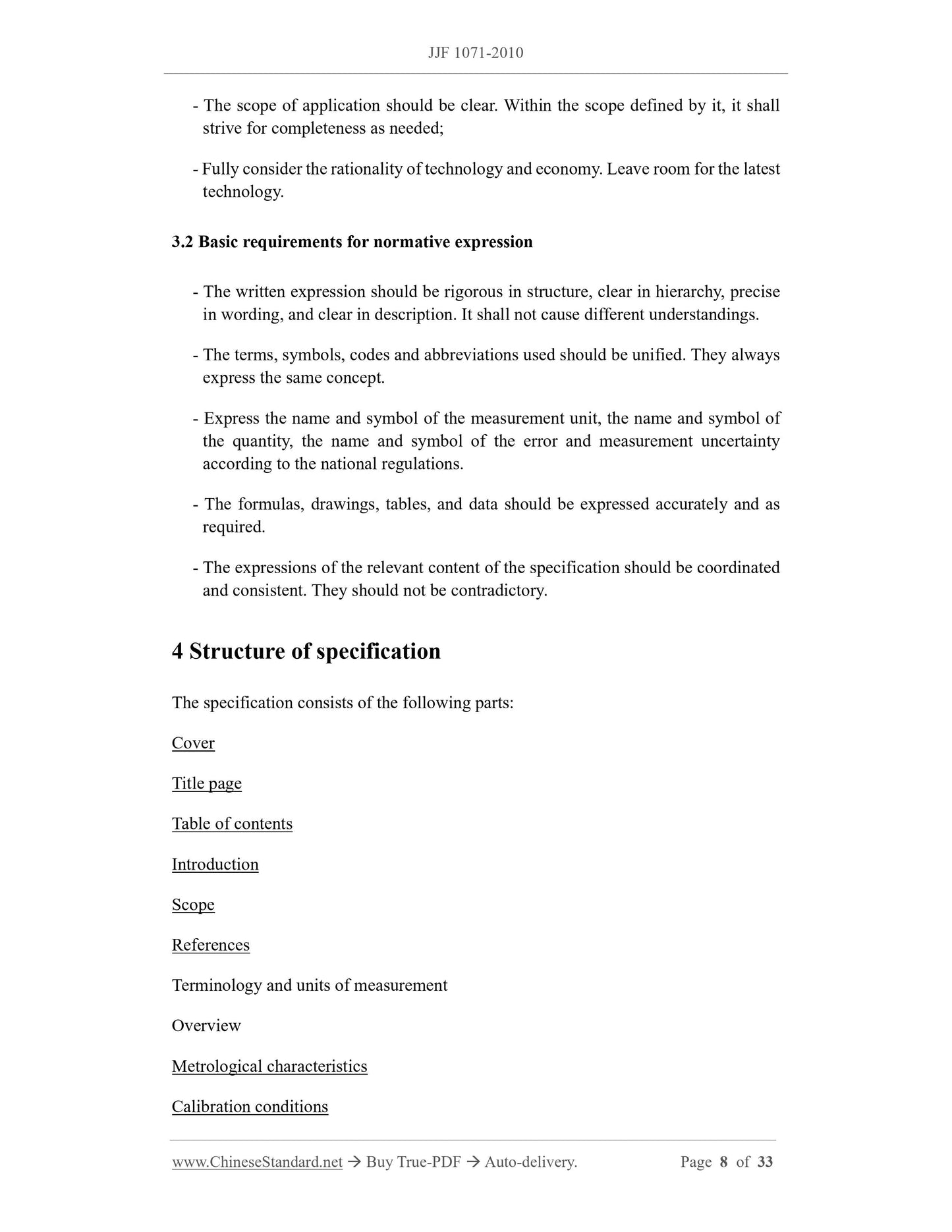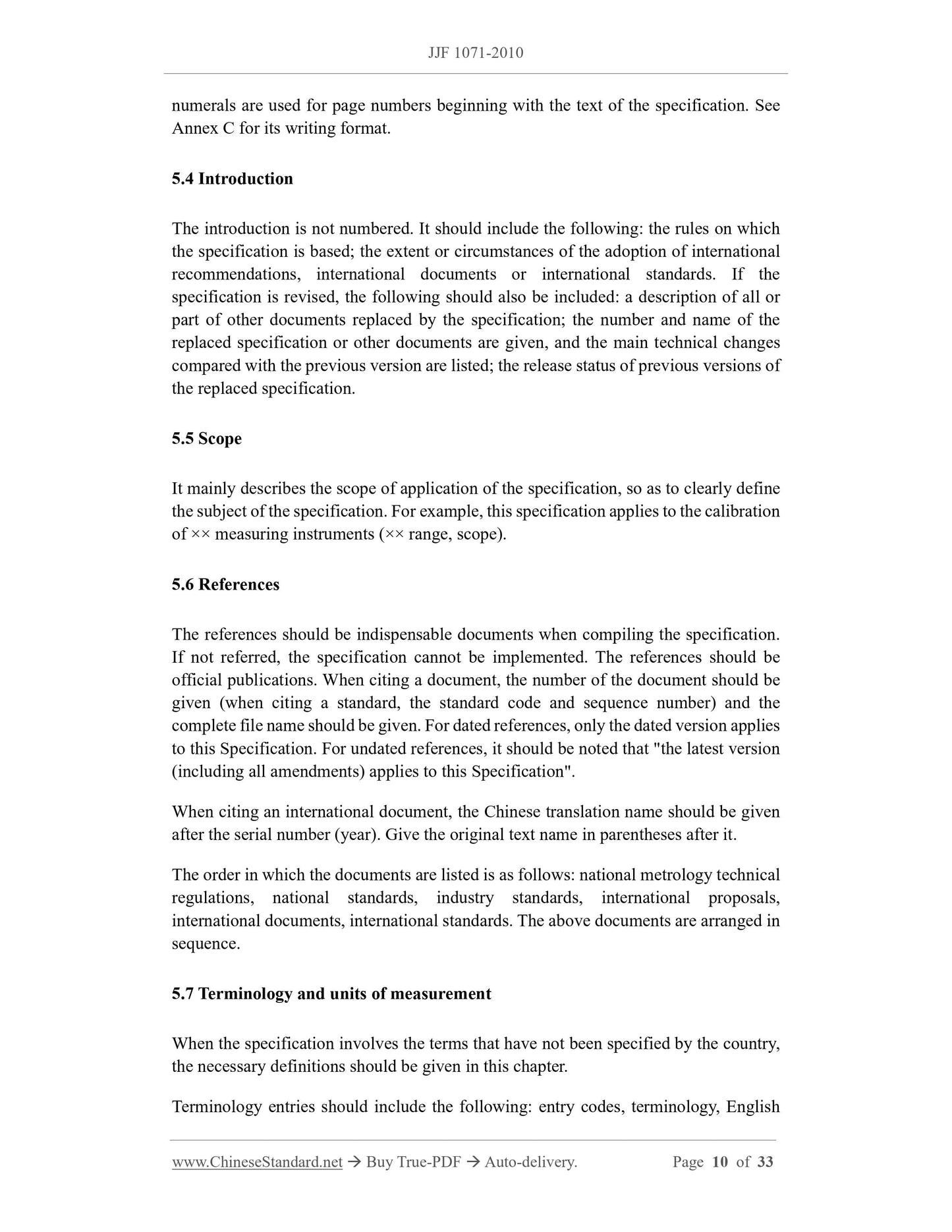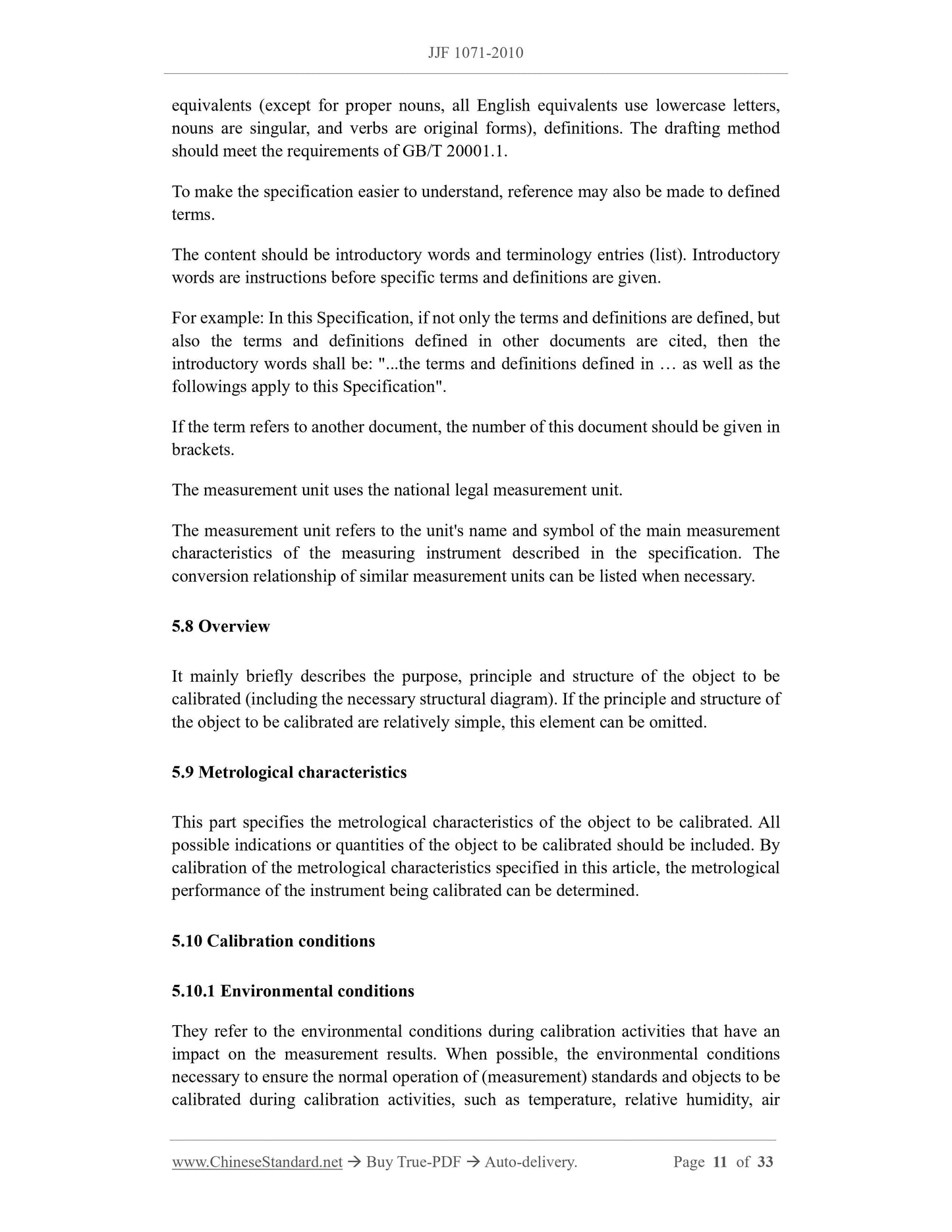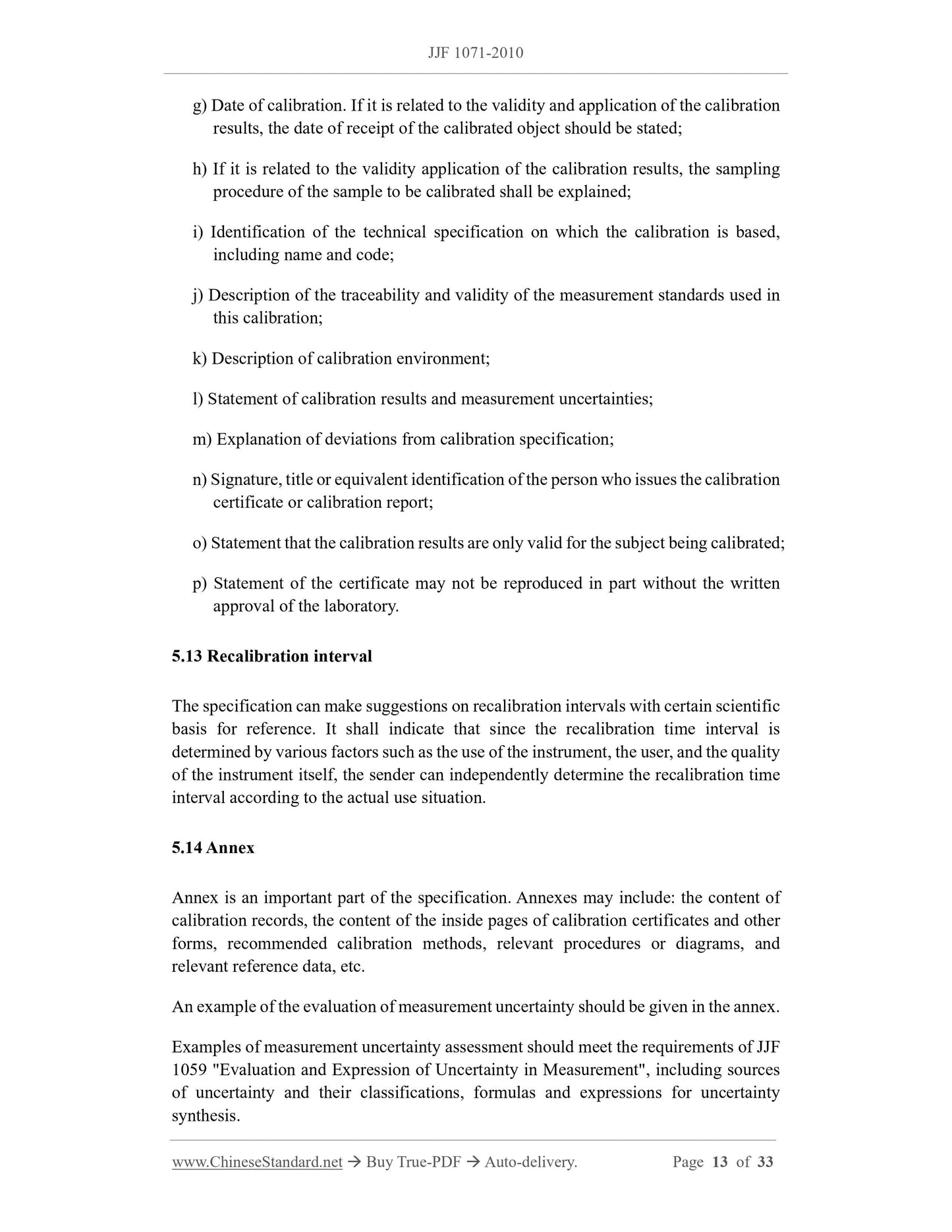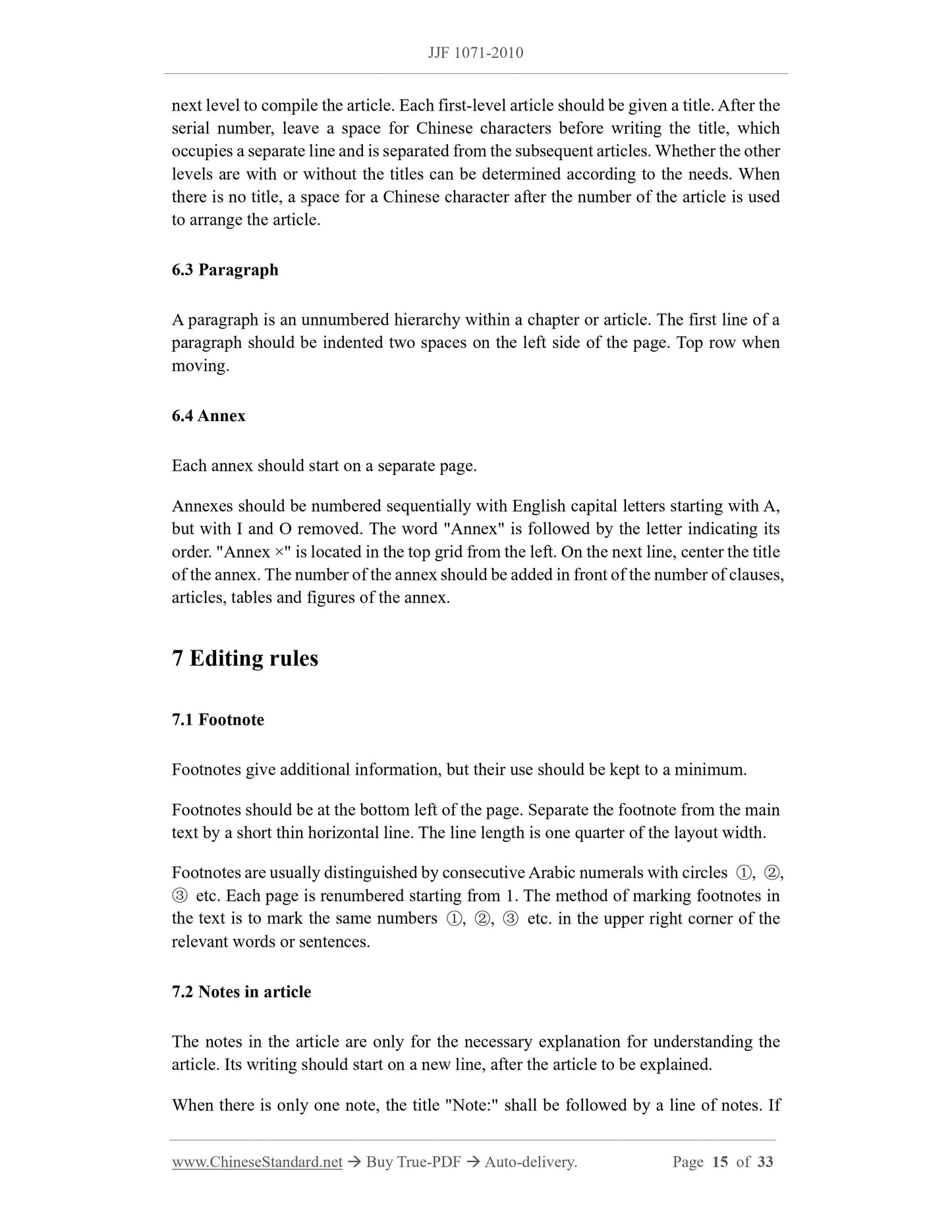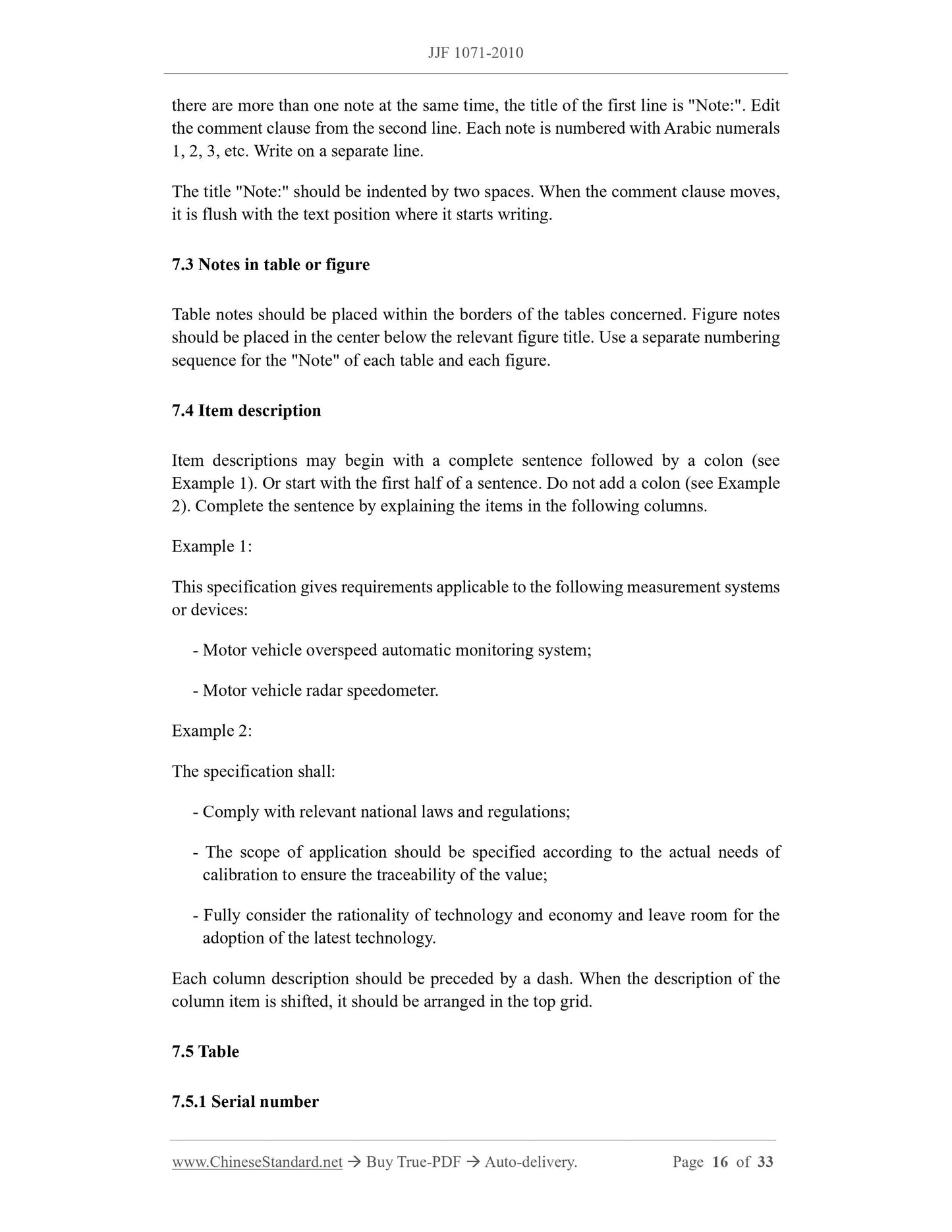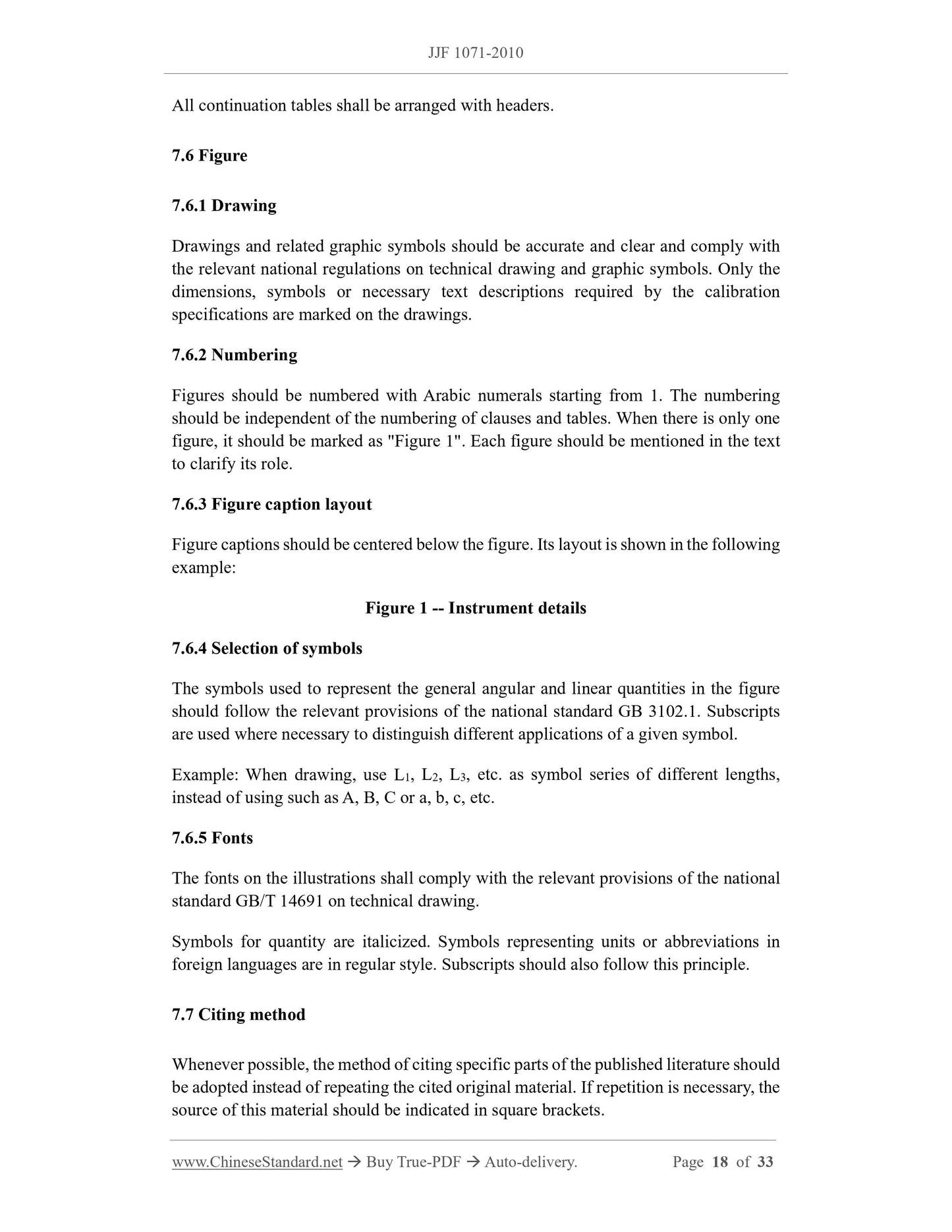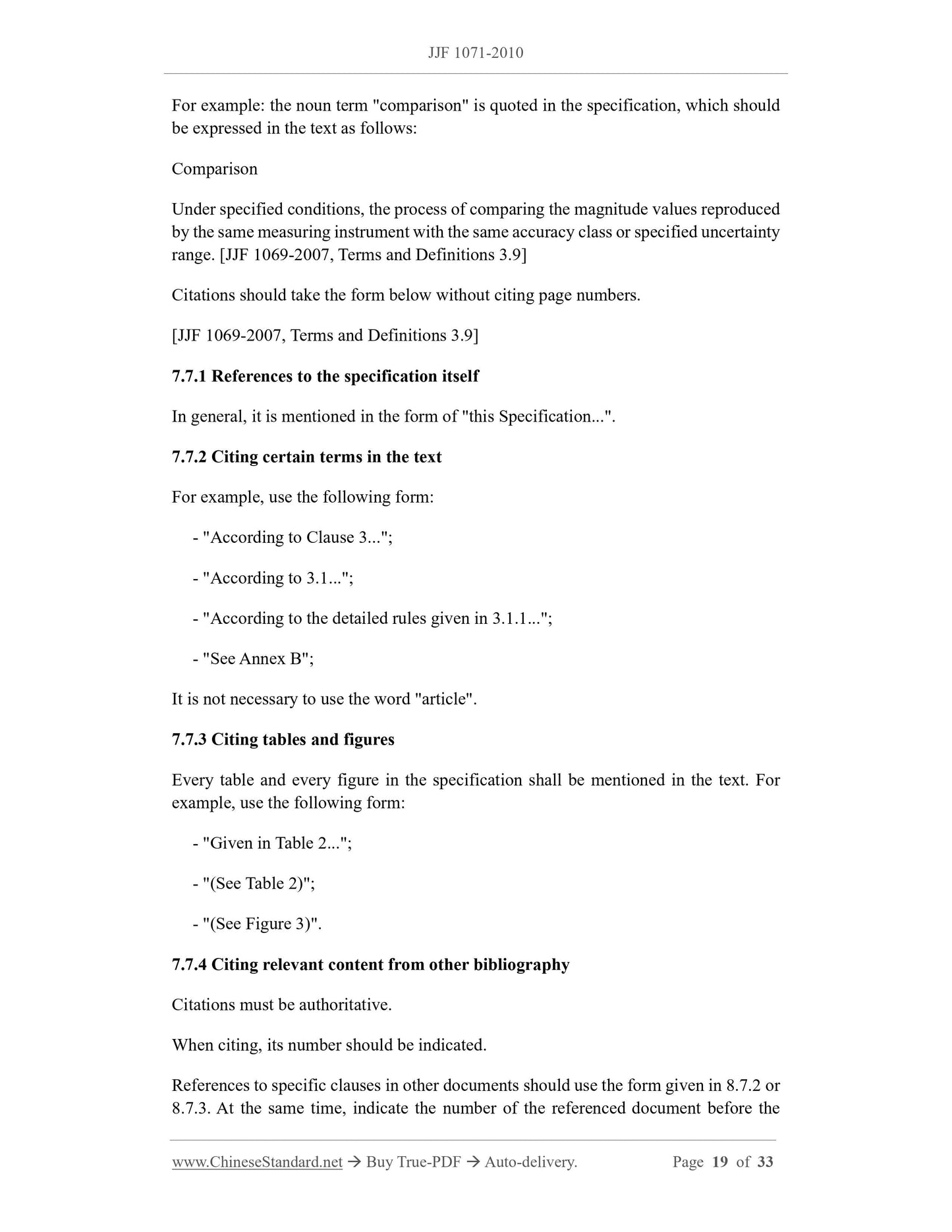1
/
of
12
PayPal, credit cards. Download editable-PDF and invoice in 1 second!
JJF 1071-2010 English PDF
JJF 1071-2010 English PDF
Regular price
$400.00 USD
Regular price
Sale price
$400.00 USD
Unit price
/
per
Shipping calculated at checkout.
Couldn't load pickup availability
Delivery: 3 seconds. Download true-PDF + Invoice.
Get QUOTATION in 1-minute: Click JJF 1071-2010
Historical versions: JJF 1071-2010
Preview True-PDF (Reload/Scroll if blank)
JJF 1071-2010: The rules for drafting national calibration specification
JJF 1071-2010
JJF
NATIONAL METROLOGY TECHNICAL SPECIFICATION
OF THE PEOPLE’S REPUBLIC OF CHINA
The Rules for Drafting National Calibration Specification
ISSUED ON: NOVEMBER 05, 2010
IMPLEMENTED ON: MAY 05, 2011
Issued by: General Administration of Quality Supervision, Inspection and
Quarantine of the People's Republic of China
Table of Contents
Introduction ... 6
1 Scope ... 7
2 Normative references ... 7
3 General ... 7
3.1 General principles for drafting specification ... 7
3.2 Basic requirements for normative expression ... 8
4 Structure of specification ... 8
5 Each part of Specification ... 9
5.1 Cover ... 9
5.2 Title page ... 9
5.3 Table of contents ... 9
5.4 Introduction ... 10
5.5 Scope ... 10
5.6 References ... 10
5.7 Terminology and units of measurement ... 10
5.8 Overview ... 11
5.9 Metrological characteristics ... 11
5.10 Calibration conditions ... 11
5.11 Calibration items and methods ... 12
5.12 Calibration results ... 12
5.13 Recalibration interval ... 13
5.14 Annex ... 13
5.15 Additional information ... 14
6 Hierarchical division ... 14
6.1 Clause... 14
6.2 Article... 14
6.3 Paragraph ... 15
6.4 Annex ... 15
7 Editing rules ... 15
7.1 Footnote ... 15
7.2 Notes in article ... 15
7.3 Notes in table or figure ... 16
7.4 Item description ... 16
7.5 Table ... 16
7.6 Figure ... 18
7.7 Citing method ... 18
7.8 Mathematical formula ... 20
7.9 Expression of numerical values ... 20
7.10 Abbreviation ... 21
7.11 Notation of values and units ... 21
7.12 Punctuation marks and simplified Chinese characters ... 21
7.13 Eyebrow line ... 21
7.14 End line ... 21
7.15 Font and font size for specification ... 21
Annex A Front and back cover format ... 23
Annex B Title page format ... 25
Annex C Format for table of contents ... 27
Annex D Example of hierarchy numbering ... 28
Annex E Example of clause and article layout ... 29
Annex F Font size and font of specification ... 32
The Rules for Drafting National Calibration Specification
1 Scope
This Rules applies to the preparation of national metrology and calibration
specifications. Calibration specifications for various laboratories can be compiled by
using it as reference.
2 Normative references
This Rules refers to the following documents:
JJF 1059, Evaluation and Expression of Uncertainty in Measurement
JJF 1069-2007, Rules for the Examination of the Service of Legal Metrological
Verification
GB/T 1.1-2009, Directives for standardization - Part 1: The structure and drafting
of standards
GB 3102.1, Quantities and units of space and time
GB/T 14691, Technical drawings - Lettering
GB/T 15834, General rules for punctuation
GB/T 15835, General rules for writing numerals in public texts
GB/T 20001.1, Rules for drafting standards - Part 1: Terminology
For dated references, only the edition cited applies. For undated references, the latest
edition of the referenced document (including any amendments) applies to this Rules.
3 General
3.1 General principles for drafting specification
The National Calibration Specification is formulated and approved by the Metrology
Administration Department of the State Council. It is implemented nationwide and
serves as a technical document for calibration. The Calibration Specification should:
- Comply with relevant national laws and regulations;
- The scope of application should be clear. Within the scope defined by it, it shall
strive for completeness as needed;
- Fully consider the rationality of technology and economy. Leave room for the latest
technology.
3.2 Basic requirements for normative expression
- The written expression should be rigorous in structure, clear in hierarchy, precise
in wording, and clear in description. It shall not cause different understandings.
- The terms, symbols, codes and abbreviations used should be unified. They always
express the same concept.
- Express the name and symbol of the measurement unit, the name and symbol of
the quantity, the name and symbol of the error and measurement uncertainty
according to the national regulations.
- The formulas, drawings, tables, and data should be expressed accurately and as
required.
- The expressions of the relevant content of the specification should be coordinated
and consistent. They should not be contradictory.
4 Structure of specification
The specification consists of the following parts:
Cover
Title page
Table of contents
Introduction
Scope
References
Terminology and units of measurement
Overview
Metrological characteristics
Calibration conditions
numerals are used for page numbers beginning with the text of the specification. See
Annex C for its writing format.
5.4 Introduction
The introduction is not numbered. It should include the following: the rules on which
the specification is based; the extent or circumstances of the adoption of international
recommendations, international documents or international standards. If the
specification is revised, the following should also be included: a description of all or
part of other documents replaced by the specification; the number and name of the
replaced specification or other documents are given, and the main technical changes
compared with the previous version are listed; the release status of previous versions of
the replaced specification.
5.5 Scope
It mainly describes the scope of application of the specification, so as to clearly define
the subject of the specification. For example, this specification applies to the calibration
of ×× measuring instruments (×× range, scope).
5.6 References
The references should be indispensable documents when compiling the specification.
If not referred, the specification cannot be implemented. The references should be
official publications. When citing a document, the number of the document should be
given (when citing a standard, the standard code and sequence number) and the
complete file name should be given. For dated references, only the dated version applies
to this Specification. For undated references, it should be noted that "the latest version
(including all amendments) applies to this Specification".
When citing an international document, the Chinese translation name should be given
after the serial number (year). Give the original text name in parentheses after it.
The order in which the documents are listed is as follows: national metrology technical
regulations, national standards, industry standards, international proposals,
international documents, international standards. The above documents are arranged in
sequence.
5.7 Terminology and units of measurement
When the specification involves the terms that have not been specified by the country,
the necessary definitions should be given in this chapter.
Terminology entries should include the following: entry codes, terminology, English
equivalents (except for proper nouns, all English equivalents use lowercase letters,
nouns are singular, and verbs are original forms), definitions. The drafting method
should meet the requirements of GB/T 20001.1.
To make the specification easier to understand, reference may also be made to defined
terms.
The content should be introductory words and terminology entries (list). Introductory
words are instructions before specific terms and definitions are given.
Fo...
Get QUOTATION in 1-minute: Click JJF 1071-2010
Historical versions: JJF 1071-2010
Preview True-PDF (Reload/Scroll if blank)
JJF 1071-2010: The rules for drafting national calibration specification
JJF 1071-2010
JJF
NATIONAL METROLOGY TECHNICAL SPECIFICATION
OF THE PEOPLE’S REPUBLIC OF CHINA
The Rules for Drafting National Calibration Specification
ISSUED ON: NOVEMBER 05, 2010
IMPLEMENTED ON: MAY 05, 2011
Issued by: General Administration of Quality Supervision, Inspection and
Quarantine of the People's Republic of China
Table of Contents
Introduction ... 6
1 Scope ... 7
2 Normative references ... 7
3 General ... 7
3.1 General principles for drafting specification ... 7
3.2 Basic requirements for normative expression ... 8
4 Structure of specification ... 8
5 Each part of Specification ... 9
5.1 Cover ... 9
5.2 Title page ... 9
5.3 Table of contents ... 9
5.4 Introduction ... 10
5.5 Scope ... 10
5.6 References ... 10
5.7 Terminology and units of measurement ... 10
5.8 Overview ... 11
5.9 Metrological characteristics ... 11
5.10 Calibration conditions ... 11
5.11 Calibration items and methods ... 12
5.12 Calibration results ... 12
5.13 Recalibration interval ... 13
5.14 Annex ... 13
5.15 Additional information ... 14
6 Hierarchical division ... 14
6.1 Clause... 14
6.2 Article... 14
6.3 Paragraph ... 15
6.4 Annex ... 15
7 Editing rules ... 15
7.1 Footnote ... 15
7.2 Notes in article ... 15
7.3 Notes in table or figure ... 16
7.4 Item description ... 16
7.5 Table ... 16
7.6 Figure ... 18
7.7 Citing method ... 18
7.8 Mathematical formula ... 20
7.9 Expression of numerical values ... 20
7.10 Abbreviation ... 21
7.11 Notation of values and units ... 21
7.12 Punctuation marks and simplified Chinese characters ... 21
7.13 Eyebrow line ... 21
7.14 End line ... 21
7.15 Font and font size for specification ... 21
Annex A Front and back cover format ... 23
Annex B Title page format ... 25
Annex C Format for table of contents ... 27
Annex D Example of hierarchy numbering ... 28
Annex E Example of clause and article layout ... 29
Annex F Font size and font of specification ... 32
The Rules for Drafting National Calibration Specification
1 Scope
This Rules applies to the preparation of national metrology and calibration
specifications. Calibration specifications for various laboratories can be compiled by
using it as reference.
2 Normative references
This Rules refers to the following documents:
JJF 1059, Evaluation and Expression of Uncertainty in Measurement
JJF 1069-2007, Rules for the Examination of the Service of Legal Metrological
Verification
GB/T 1.1-2009, Directives for standardization - Part 1: The structure and drafting
of standards
GB 3102.1, Quantities and units of space and time
GB/T 14691, Technical drawings - Lettering
GB/T 15834, General rules for punctuation
GB/T 15835, General rules for writing numerals in public texts
GB/T 20001.1, Rules for drafting standards - Part 1: Terminology
For dated references, only the edition cited applies. For undated references, the latest
edition of the referenced document (including any amendments) applies to this Rules.
3 General
3.1 General principles for drafting specification
The National Calibration Specification is formulated and approved by the Metrology
Administration Department of the State Council. It is implemented nationwide and
serves as a technical document for calibration. The Calibration Specification should:
- Comply with relevant national laws and regulations;
- The scope of application should be clear. Within the scope defined by it, it shall
strive for completeness as needed;
- Fully consider the rationality of technology and economy. Leave room for the latest
technology.
3.2 Basic requirements for normative expression
- The written expression should be rigorous in structure, clear in hierarchy, precise
in wording, and clear in description. It shall not cause different understandings.
- The terms, symbols, codes and abbreviations used should be unified. They always
express the same concept.
- Express the name and symbol of the measurement unit, the name and symbol of
the quantity, the name and symbol of the error and measurement uncertainty
according to the national regulations.
- The formulas, drawings, tables, and data should be expressed accurately and as
required.
- The expressions of the relevant content of the specification should be coordinated
and consistent. They should not be contradictory.
4 Structure of specification
The specification consists of the following parts:
Cover
Title page
Table of contents
Introduction
Scope
References
Terminology and units of measurement
Overview
Metrological characteristics
Calibration conditions
numerals are used for page numbers beginning with the text of the specification. See
Annex C for its writing format.
5.4 Introduction
The introduction is not numbered. It should include the following: the rules on which
the specification is based; the extent or circumstances of the adoption of international
recommendations, international documents or international standards. If the
specification is revised, the following should also be included: a description of all or
part of other documents replaced by the specification; the number and name of the
replaced specification or other documents are given, and the main technical changes
compared with the previous version are listed; the release status of previous versions of
the replaced specification.
5.5 Scope
It mainly describes the scope of application of the specification, so as to clearly define
the subject of the specification. For example, this specification applies to the calibration
of ×× measuring instruments (×× range, scope).
5.6 References
The references should be indispensable documents when compiling the specification.
If not referred, the specification cannot be implemented. The references should be
official publications. When citing a document, the number of the document should be
given (when citing a standard, the standard code and sequence number) and the
complete file name should be given. For dated references, only the dated version applies
to this Specification. For undated references, it should be noted that "the latest version
(including all amendments) applies to this Specification".
When citing an international document, the Chinese translation name should be given
after the serial number (year). Give the original text name in parentheses after it.
The order in which the documents are listed is as follows: national metrology technical
regulations, national standards, industry standards, international proposals,
international documents, international standards. The above documents are arranged in
sequence.
5.7 Terminology and units of measurement
When the specification involves the terms that have not been specified by the country,
the necessary definitions should be given in this chapter.
Terminology entries should include the following: entry codes, terminology, English
equivalents (except for proper nouns, all English equivalents use lowercase letters,
nouns are singular, and verbs are original forms), definitions. The drafting method
should meet the requirements of GB/T 20001.1.
To make the specification easier to understand, reference may also be made to defined
terms.
The content should be introductory words and terminology entries (list). Introductory
words are instructions before specific terms and definitions are given.
Fo...
Share
